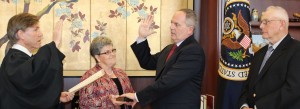In August of 2005, the PTO revised the MPEP to include a new section 2111.04. This new section of the MPEP addressed the language “adapted to.” While the new section of the MPEP cited case law for other phrases, such as “whereby” clauses, no legal support was cited in regard to the “adapted to” language. Eight years and six revisions of the MPEP later, no legal support has yet been cited. Section 2111.04 is reproduced below:
2111.04 “Adapted to,” “Adapted for,” “Wherein,” and “Whereby” Clauses [R-9]
Claim scope is not limited by claim language that suggests or makes optional but does not require steps to be performed, or by claim language that does not limit a claim to a particular structure. However, examples of claim language, although not exhaustive, that may raise a question as to the limiting effect of the language in a claim are:
(A) “adapted to” or “adapted for” clauses;
(B) “wherein” clauses; and
(C) “whereby” clauses.
The determination of whether each of these clauses is a limitation in a claim depends on the specific facts of the case. > See, e.g., Griffin v. Bertina, 283 F.3d 1029, 1034, 62 USPQ2d 1431 (Fed. Cir. 2002)(finding that a “wherein” clause limited a process claim where the clause gave “meaning and purpose to the manipulative steps”). < In Hoffer v. Microsoft Corp., 405 F.3d 1326, 1329, 74 USPQ2d 1481, 1483 (Fed. Cir. 2005), the court held that when a “‘whereby’ clause states a condition that is material to patentability, it cannot be ignored in order to change the substance of the invention.” Id. However, the court noted (quoting Minton v. Nat’l Ass’n of Securities Dealers, Inc., 336 F.3d 1373, 1381, 67 USPQ2d 1614, 1620 (Fed. Cir. 2003)) that a “‘whereby clause in a method claim is not given weight when it simply expresses the intended result of a process step positively recited.’” Id.
It is worth noting that in the recent case of Broadcom Corporation v. EMULEX CORPORATION, No. 2012-1309 (Fed. Cir. Oct. 7, 2013) an “adapted to” phrase was at issue in the appeal. The claim at issue was claim 8 which recited:
8. A communication device configured to receive multiple serial data signals, comprising:
a master timing generator adapted to generate a master timing signal;
multiple receive-lanes each configured to receive an associated one of the multiple serial data signals, each receive-lane including
a phase interpolator adapted to produce a sampling signal having an interpolated phase, and
a data path adapted to sample and quantize the associated serial data signal in accordance with the sampling signal; and
an interpolator control module coupled to each receive-lane, the interpolator control module being adapted to cause the phase interpolator in each receive-lane to rotate the interpolated phase of the sampling signal in the receive-lane at a rate corresponding to a frequency offset between the sampling signal and the serial data signal associated with the receive-lane so as to reduce the frequency offset between the sampling signal and the serial data signal.
The court in Broadcom noted that the determination of infringement at the district court level had turned on a particular limit in claim 8 — a closer look at claim 8 reveals that the language at issue was actually part of an “adapted to” claim. The Federal Circuit stated:
At trial, the district court found that, at bottom, infringement turned on whether the accused products “reduced the offset between the sampling signal and the data signal all of the time or only some of the time.” J.A. 35. Importantly, the district court found that Emulex’s expert, Dr. Nikolic, conceded that the accused device “reduced the offset at least some of the time.” J.A. 640; see Oral Argument at 1:19-1:48, Broadcom Corp. v. Emulex Corp., No. 2012-1309, available at http:// www.cafc.uscourts.gov/oral-argument-recordings/12-1309/ all. It is well settled that an accused device that “sometimes, but not always, embodies a claim[] nonetheless infringes.” Bell Commc’n Research, Inc. v. Vitalink Commc’n Corp., 55 F.3d 615, 622-23 (Fed. Cir. 1995). Accordingly, this court affirms the district court’s grant of JMOL that Emulex’s accused products infringed the ‘150 patent and denial of Emulex’s JMOL of noninfringement.
Thus, the Federal Circuit affirmed the finding of infringement based on language appearing in an “adapted to” limitation.
Incidentally, this past week the US Patent Office issued at least 500 patents that include “adapted to” in one or more claims.
